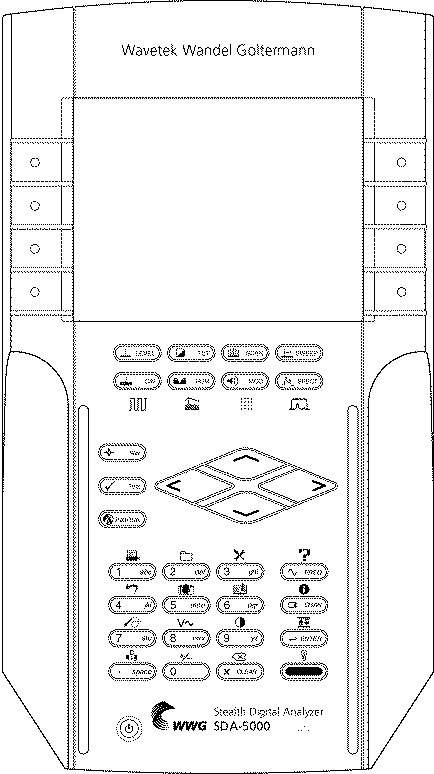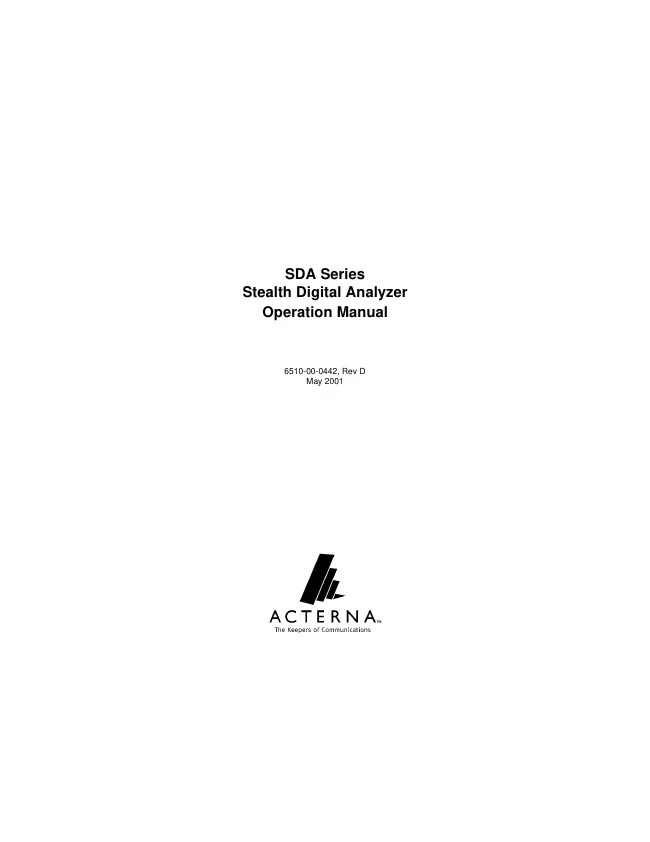Acterna - SDA-5000 - Analyzer
Manufacturer:

Image 1 of 1
If you have any other photos or manuals for the
Acterna SDA-5000
you can
upload the files here.
Equipment:
SDA-5000
Date:
2001
Category:
Group:
Sub Group:
Information
The Stealth Digital Analyzer (SDA) cable network measurement
tools test a wide range of critical parameters, helping you
prove and maintain your system’s performance. Advanced
features include tools to support preventative maintenance
programs for improving network quality.
Applications include aligning amplifiers such as optical
nodes, testing the performance of both forward and reverse
path networks, finding and fixing sources of reverse path
ingress, measuring signal quality (both continuous and
bursty digital carriers), and fulfilling FCC and CENELEC
proof-of-performance requirements.
You can perform comprehensive troubleshooting and
preventative maintenance tests with accuracy and ease using
Acterna’s SDA products:
• Quickly check frequency response, signal levels, hum,
carrier-to-noise (C/N) ratio, depth of modulation, and
monitor the general performance of the cable system
• Perform tests without interfering with CATV subscribers'
service
• Evaluate system performance precisely and diagnose and
eliminate problems quickly to maintain quality operation of
your CATV system equipment.
Acterna’s Stealth Sweep System consists of at least two
major components:
a headend transmitter and a field receiver.
FIELD UNIT (SDA-5000)
The SDA field receivers conduct a battery of signal level
measurements, including a full scan of the cable spectrum to
1 GHz, in addition to performing sweep reception. A
proprietary digital signal processing (DSP) technique
measures hum and carrier-to-noise (C/N) ratio on modulated
carriers.
The receivers are streamlined, hand-held instruments
weighing approximately 7.5 pounds. A 320 X 240 backlighted
dot matrix LCD shows measurement data in both graphical and
numerical formats. An extended-life Nickel Metal Hydride
(NiMH) battery (typically 4-5 hours operating time)
is standard.
Features of the SDA-5000 include:
• Fast scanning and spectrum analysis for ingress and noise
detection (catch bursty noise as fast as 5 microseconds)
• A desired/undesired TDMA (Time Division Multiple Access)
digital carrier analysis allowing you to see the quality and
performance of cable modems and digital set-top boxes in the
reverse path
• Simple operation through the expanded and redesigned
Navigator interface
• Built in pre-amp for reverse path alignment and analysis
that reduces the jumper cables and assorted boxes you must
carry and simplifies alignment methods. The pre-amp also
allows you to better see ingress and noise from high value
test points.
These features address advanced services such as Internet,
IP telephony, digital video, QAM analysis, and DVB.
Acterna offers current Stealth customers upgrade paths for
units already purchased.
Quickly find entry points for ingress and noise
• Fast peak detection circuits see ingress from even
transient noise sources
• Programmable dwell-time in spectrum mode
• “Dwell” on each frequency longer to find more of the noise
more quickly
• Zero span offers infinite dwell
• Fast spectrum scanning makes searching for ingress
interactive, eliminating the wait for the trace to ‘acquire’
• Observe noise signals clearly with the built-in pre-amp.
Instead of needing to guess about a signal that is just
above the noise floor, the built-in pre-amp allows you to
clearly see and diagnose noise
• Easily see the difference between meter-induced
intermodulation and system intermodulation and CPD (common
path distortion). A built-in low-pass filter strips away
higher power forward path signals to examine just the
reverse path
• Save money, connections, and time. Carry just one box with
all the tools needed to find ingress.
1 Manual
User manual
Manual type:
User manual
Pages:
410
Size:
9.2 MB
Language:
english
Revision:
D
Manual-ID:
6510-00-0442
Date:
May 2001
Quality:
Electronic document, no scan, very well readable.
Upload date:
Aug. 16, 2018
MD5:
b0a73323-7ca2-38f1-7e71-7ac62136a3ec
Downloads:
1465
